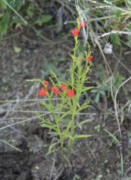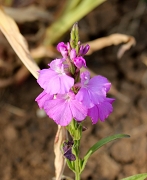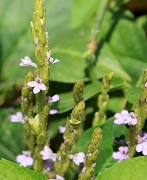Striga Genome Project

Striga asiatica

Striga hermonthica

Striga gesnorioides
What is Striga?
Approximately 1% of angiosperms (3500–4000 species) are parasitic plants that rely on water and nutrient supplies from their host plants. Whereas some parasitic plants are listed as endangered species, others are recognized as destructive agricultural pests. Among them, plants in the Orobanchaceae, such as Orobanche (including Phelipanche) and Striga, cause serious damage especially in sub-Saharan Africa, Europe and parts of Asia. The infested area has widened as large-scale monoculture of their hosts, that is, cereals, vegetables and legume crops, becomes more common in these regions. The infected hosts become stunted and withered, ending up with yield losses of 20–100%. Esti- mates of the infested area and yield losses from Striga infestation in Africa alone range up to 50 million ha and $7 billion US annually, affecting 300 million farmers.
REVIEWS:
Ichihashi, Y., Mutuku, J.M., Yoshida, S., and Shirasu, K. (2015) Transcriptomics exposes the uniqueness of parasitic plants. Briefings in Functional Genomics 14: 275-282.
Yoshida, S. and Shirasu, K. Plants that attack plants: molecular elucidation of plant parasitism. (2012) Curr Opin Plant Biol 15:708-713
Spallek, T., Mutuku, M., and Shirasu, K. The genus Striga: a witch profile. (2013) Mol Plant Path 14:861-869
What is the purpose of the Striga genome project
To understand biology of Striga, a parasitic plant which causes a devastating damage in Africa, an to build strategies to fight against it, we obtain its genomic blue print.
What can we learn from the genomic blue print?
Straiga is a plant that is able to parasitize other plants. What kind of genes are required for the parasitism? Striga should have unique genes which other plants do not have, or is it true? If any, let's find them. Striga is a plant that is made of different organs. Especially, the infectious organ is called "haustorium". If we can disturb specifically haustorium, we could stop them infecting. In other words, we will find the Achlles' heel of Striga. We will also find genes that Striga stolen from host plants. How many are there? How did Striga steal them? Such secrets of Striga will be revealed. Striga will be the first Orobanchaceae plant whose genome is revealed. Thus the Striga genome plays an important role as a reference for other Orobanchaceae.
How can we use the genomic blue print?
We can use the genome as a reference for the transcriptomic analyses. By using RNA-seq, a genome-wide method to analyse which genes are expressed in a sample, we will reveal genes involved in its parasitism. In addition, the reference genome is required for proteomics analyses. We will be able to tell which proteins are specifically modified in infection. Furthermore, these analyses will be combined with metabolomics to understand what kind of compounds Striga makes in its infection.
Which Striga genome is sequenced?
The most devestating parasitic plant in the world is Striga hermonthica. However, S. hermonthica is an outcrossing plant and thus the heterogeneity of genome is high, making genome assembly very difficult. Because of this reason, we first sequenced Striga asiatica, a selfing plant and perform its assembly.
What is the methodology?
We used Illumina HiSeq2000 to perform Pair-End (PE) and Mate Pair (MP) sequencing . We constructed 200bp, 500bp, 5Kbp, 10Kbp, libraries. In addition we constructed a BAC library and sequence BAC ends by Sanger sequencing.
What about other parasitic plants?
We will sequence genomes of Phtheirospermum japanicum, a Orobanhcaceae plant and compare with Striga.
Which paper is describing the Striga genome?
Yoshida et al. Genome sequence of Striga asiatica provides insight into the evolution of plant parasitism. (2019) Curr. Biol.in press
Genome Sequence Download
http://datadryad.org/resource/doi:10.5061/dryad.53t3574
APPENDIX
Related International Societies
The International Parasitic Plant Society
Databases
RIKEN Striga EST database
Parasitic Plant Genome Project (USA)
Striga Researchers
Univ. Verginia Michael Timko (USA)
Claude dePamphilis (USA)
Univ. Shefield Julie Scholes (UK)

